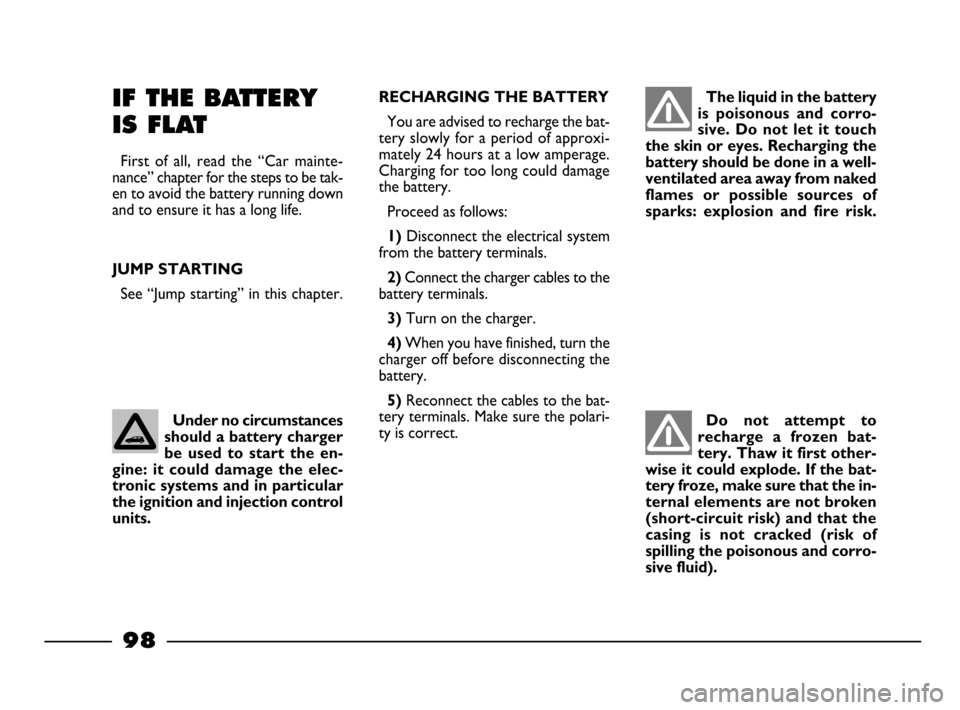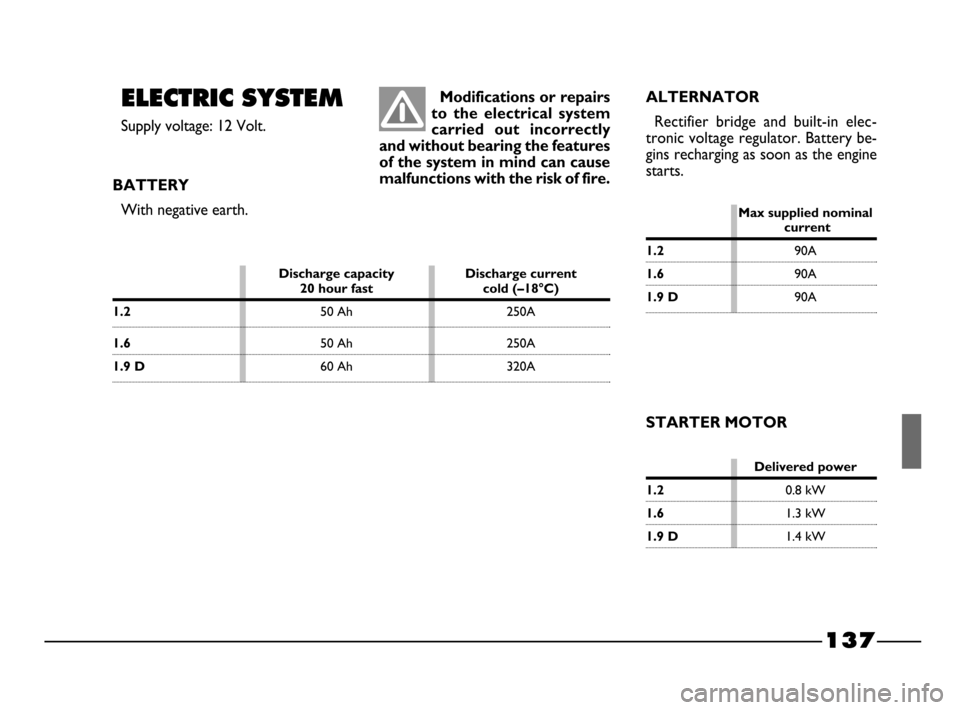charging FIAT PALIO 2003 178 / 1.G India Version Owners Manual
[x] Cancel search | Manufacturer: FIAT, Model Year: 2003, Model line: PALIO, Model: FIAT PALIO 2003 178 / 1.GPages: 156, PDF Size: 6.27 MB
Page 36 of 156

35
WARNING
LIGHTS
The warning lights come on in the
following circumstances:
BATTERY NOT
CHARGING PROPER-
LY (red)
When there is
a fault in the current gen-
erating system.
Go to a
Fiat Dealershipand pre-
vent deploying the battery.
When the key is turned to
MAR the
light comes on but should go out the
moment the engine is started.
LOW ENGINE OIL
PRESSURE (red)
When
the engine oil pressure
drops under the normal
value.
When the key is turned to
MARthe
light comes on but should go out the
moment the engine is started.
A delay in the light going out is ac-
ceptable only when the engine is idling.
If the engine has been heavily taxed,
the light may flash when the engine re-
turns to idle. The light should howev-
er go out when you accelerate slight-
ly.
v
w
If the vwarning light
comes on while the car is
moving, stop the engine
immediately and contact a Fiat
Dealership.
INJECTION SYSTEM
FAILURE (red) (petrol
version)
When there is a
fault in the injection system.
When the ignition key is turned to
the
MAR position, the light comes on
but should go out after a few seconds.
The warning light will stay on or
come on when travelling to indicate
imperfect operation of the injection
system with possible loss of perfor-
mance, poor handling and higher con-
sumption.
g
In these conditions, you can contin-
ue driving but you should avoid de-
manding efforts from the engine or
high speeds. Contact a
Fiat Dealer-
ship
as soon as possible.
Using the car for long periods when
the warning light is on may cause dam-
age especially when the engine is run-
ning irregularly or misfiring. The car
should only be used for short periods
at low speeds.
Occasional and brief lighting of the
warning light is meaningless.
HANDBRAKE EN-
GAGED / LOW
BRAKE FLUID (red)
In
two cases:
1.When the handbrake is applied.
2. when the brake fluid level falls be-
low the minimum level.
x
20-63 03/03/2003 06:02 PM Page 35
Page 99 of 156

98
IF THE BATTERY
IS FLAT
First of all, read the “Car mainte-
nance” chapter for the steps to be tak-
en to avoid the battery running down
and to ensure it has a long life.
JUMP STARTING
See “Jump starting” in this chapter.
RECHARGING THE BATTERY
You are advised to recharge the bat-
tery slowly for a period of approxi-
mately 24 hours at a low amperage.
Charging for too long could damage
the battery.
Proceed as follows:
1) Disconnect the electrical system
from the battery terminals.
2)Connect the charger cables to the
battery terminals.
3)Turn on the charger.
4)When you have finished, turn the
charger off before disconnecting the
battery.
5)Reconnect the cables to the bat-
tery terminals. Make sure the polari-
ty is correct.
Under no circumstances
should a battery charger
be used to start the en-
gine: it could damage the elec-
tronic systems and in particular
the ignition and injection control
units. The liquid in the battery
is poisonous and corro-
sive. Do not let it touch
the skin or eyes. Recharging the
battery should be done in a well-
ventilated area away from naked
flames or possible sources of
sparks: explosion and fire risk.Do not attempt to
recharge a frozen bat-
tery. Thaw it first other-
wise it could explode. If the bat-
tery froze, make sure that the in-
ternal elements are not broken
(short-circuit risk) and that the
casing is not cracked (risk of
spilling the poisonous and corro-
sive fluid).
80-103 03/03/2003 06:49 PM Page 98
Page 138 of 156

Delivered power
1.20.8 kW
1.61.3 kW
1.9 D1.4 kW
137
ALTERNATOR
Rectifier bridge and built-in elec-
tronic voltage regulator. Battery be-
gins recharging as soon as the engine
starts.
STARTER MOTOR Modifications or repairs
to the electrical system
carried out incorrectly
and without bearing the features
of the system in mind can cause
malfunctions with the risk of fire.
ELECTRIC SYSTEM
Supply voltage: 12 Volt.
BATTERY
With negative earth.
Discharge capacity Discharge current 20 hour fast cold (–18°C)
1.250 Ah 250A
1.650 Ah 250A
1.9 D60 Ah 320A
Max supplied nominalcurrent
1.290A
1.690A
1.9 D90A
128-143 03/03/2003 07:39 PM Page 137
Page 145 of 156

Abord instrument ................... 33
ABS ................................................. 56
Accessories Purchased
Air cleaner (replacement) ....... 116
Air bag ........................................... 58
Air re-circulation.......................... 40
Air vents......................................... 38
Alternator (specifications) ........ 137
Ashtray ........................................... 47
Battery
- jump starting ......................... 81
- specifications........................... 137
- with optical hydrometer .... 119
- useful advices .......................... 118
- maintenance ............................ 118
- recharging ................................ 98
Bodywork
- bodywork type code ........... 130
- maintenance .......................... 125Boot
- extending ................................. 52
- tailgate opening/closing ........ 16-51
Brake lights
(bulb replacement) ................. 90
Brake-clutch fluid level ............... 115
Brakes
- service and emergency ....... 134
- fluid level ................................ 115
Bulb (replacement) ..................... 86
- bulb types ............................... 86
By the Owner ............................... 79Car dimensions ......................... 139
Car maintenance ......................... 104
Ceiling lights
- control ..................................... 46
- bulb replacement ................... 92
Centralized locking .................... 17-49
Chassis(marking) ......................... 129
Cheap running that respects
the environment ..................... 73
Checking the levels .................... 111
Children safety ............................ 18-49
Climate control system- climate ..................................... 39
- controls.................................... 14-39
- fast demisting ........................ 40
- maintenance .......................... 125
- air re-circulation .................... 40
- heating ...................................... 39
Climate/heating control
system ........................................ 37
Clutch ............................................. 133
Containing running costs and
pollution .................................... 75
Control switches ........................ 15-44
Correct use of your car ............ 64
Dashboard ................................ 9
Demisting ....................................... 40
- rear window .......................... 40
- windscreen and side
window ...................................... 40
Differential ..................................... 133
Digital clock ................................. 34
INDEX
144
144-152 03/03/2003 07:30 PM Page 144